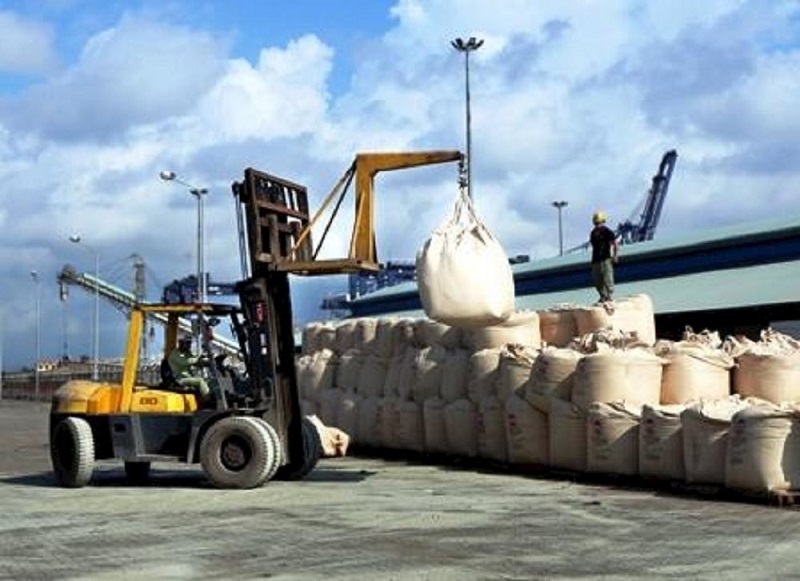The capacity of Vietnam's cement industry in 2023 will reach more than 120 million tons (if the ratio of additives is adjusted up, the production capacity will be over 140 million tons), while domestic consumption is forecasted only about 65 million tons and exports will hardly reach 31 million tons as in 2022.
EXPORT FELL TO A RECORD
Following the decline of the whole year of 2022, exports of cement and clinker in the first quarter of 2023 continued to suffer from inflation from major markets such as China, Bangladesh and the Philippines, making export volume and value both record drop.
Export volume in the first quarter of 2023 decreased by 25% over the same period, reaching only 8.1 million tons, with a turnover of 345 million USD, down 24.6% (equivalent to a decrease of over 100 million USD).
Cement exports to China continue to be gloomy because the real estate market has not recovered. Export of this item to China in the first quarter of 2023 only reached nearly 11.4 million USD, down 95% over the same period.

The Vietnam Cement Association (VNCA) stated that the export of cement and clinker in 2023 would continue to be difficult when the construction demand of the main market, China, remained quiet. Although China has reopened, the real estate market of this country has not recovered, leading to difficulties in VietNam's cement and clinker exports.
The second largest export market is the Philippines, which recently announced the imposition of a temporary anti-dumping tax on Vietnamese cement. The source of this case is that in early 2021, a number of cement manufacturers in the Philippines sued cement exporters from Vietnam to the Philippines for dumping, causing damage to the Philippine cement industry.
Accordingly, a series of big names in the industry such as Long Son, Ha Long, Thang Long, Vissai Ninh Binh, Vicem Tam Diep, Vicem Hai Phong ... are all subjected to temporary dumping tax. Some commercial enterprises are taxed quite high, up to 23%.
In addition, the increase in export tax on clinker products from 5% to 10% from January 1, 2023 is also causing businesses to suffer because the selling price is not enough to cover production costs and taxes.
"In the context that the price of export clinker does not increase, having to bear more taxes will reduce the competitiveness of the businesses," said VNCA Chairman Nguyen Quang Cung.
Facing a series of internal and external factors, in 2022, the total export volume of cement and clinker only reached 30.65 million tons, down 33% compared to 2021. In which, cement exports reached 15.68 million tons, equal to 93% compared to 2021, clinker exports reached 14.97 million tons, only 80% compared to 2021.
The total value of foreign currency earned from the export of cement and clinker in 2022 reached 1.36 billion USD, down 398 million USD compared to 2021. Vietnam Cement Corporation (VICEM) last year also did not complete the budget to export cement and clinker. In which, cement exports only reached 3.25 million tons, equal to 82% of that in 2021 and equal to 92% of the year butget; clinker exports equal 61.5% in 2021 and reached 81.9% of the year budget.
THE YEAR 2023 IS STILL MURKY
In 2023, cement businesses are forecasted to continue to face many difficulties in terms of markets, both domestic and export. Talking to a reporter of VietNam Investment Review, a representative of a cement business in Ninh Binh admitted that exports in the first quarter of 2023 decreased by 30% over the same period and was forecasted to decrease in the second quarter of 2023 due to a lack of orders, export prices were forced down so much.
“Export clinker is subject to 10% tax under VietNam's policy, cement exported to the Philippines is subject to anti-dumping tax, while cement production costs increase due to increased prices of raw materials, fuel and other input materials, so it is difficult to avoid losses when exporting," said this cement business.
In the current large oversupply condition, when the total capacity exceeds 120 million tons and continues to be supplemented with new supply lines, while the domestic demand for cement is only 64-65.5 million tons, leading to increasingly fierce competition.
In the context of cement producers facing pressure to consume manufactured products, maintaining traditional export markets such as the Philippines, China and Bangladesh is "vital" for businesses whose main consumer market is export.
At this time, manufacturers with large export volumes are trying to reduce production costs, find new markets, maintain traditional partners in the Philippines, and accept to adapt to protectionist trading policies, anti-dumping tax policy ..., in order to most effectively implement the export of products.
Currently, 3 main export markets of VietNam cement are the Philippines, the US and Hong Kong. For clinker, the main markets are China, Bangladesh, Philippines.
Souce: VietNam Investment Review